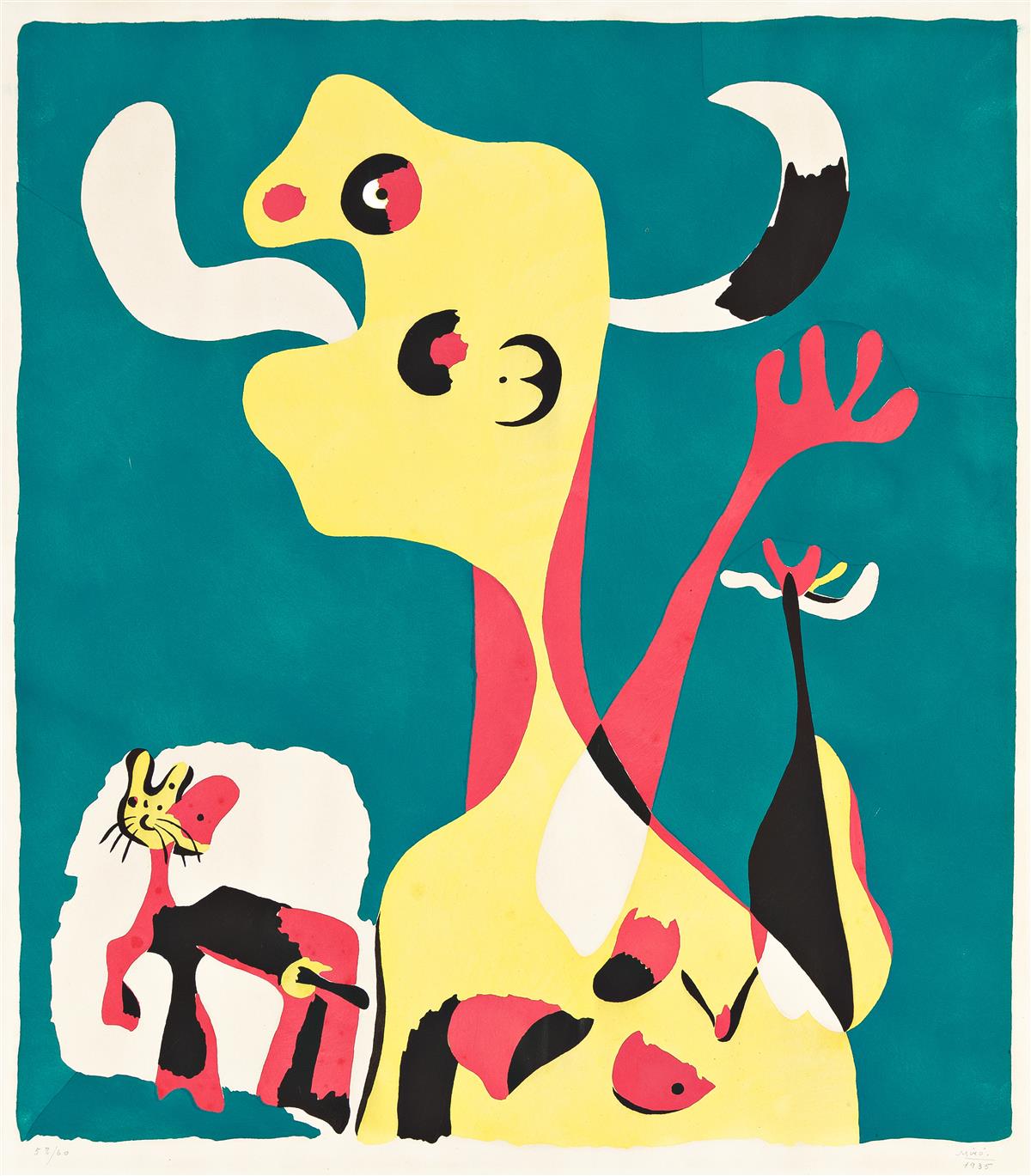Sale 2630 - Lot 137
Unsold
Estimate: $ 25,000 - $ 35,000
JOAN MIRÓ
Femme et Chien devant la Lune.
Color pochoir, 1935-36. 503x450 mm; 20x17 3/4 inches, wide margins. Signed, dated and numbered 58/60 in pencil, lower margin. Published by Adlan, Barcelona. A superb, richly-inked impression of this very scarce, early print, with vibrant colors.
Miró overwhelmingly expressed his anguish and horror with regard to the Spanish Civil War, the totalitarian regime of Spanish dictator Francisco Franco and the onset of World War II through the subject matter of his works during the late 1930s. According to The Museum of Modern Art, New York, which has an impression of the current work, "It was through contact with Surrealist poets and painters in Paris in the 1920s that Joan Miró (1893-1983) evolved his visual language of signs. With curvilinear lines and biomorphic shapes, he sought to meld the realm of the unconscious to essential life forms, veering toward abstraction but always maintaining links to humanity, nature, and the cosmos.
Miró's relationship to printmaking was tentative at first, with benefit prints such as Daphnis et Chloé for the periodical Minotaure, and [the current work] Femme et Chien devant la Lune for an association of artists in Barcelona. It was when he was introduced to the painter Louis Marcoussis, who maintained a printshop in his studio, that he took up printmaking in earnest, and his natural inclinations toward new tools and materials blossomed. His methodical working process also suited these efforts, and prints of the Black and Red Series, created there, demonstrate his systematic use of more than one copperplate and his experiments with color inking. . . . Miró continued his exploration of intaglio techniques at Stanley William Hayter's Atelier 17 workshop in New York in the 1940s, when he was there on an extended visit. Soon after, he began his active involvement with lithography through the instigation of his Parisian dealer Aimé Maeght, making numerous individual prints, as well as posters, invitations, catalogue covers, and even holiday cards. He also turned increasingly to illustrated books, a format he had attempted earlier in his career, and created twentieth-century landmarks like À Toute épreuve. Further discoveries followed, with Miró making more than two thousand prints in all, always expanding his creativity through his love of technique and process." Dupin 18.
Femme et Chien devant la Lune.
Color pochoir, 1935-36. 503x450 mm; 20x17 3/4 inches, wide margins. Signed, dated and numbered 58/60 in pencil, lower margin. Published by Adlan, Barcelona. A superb, richly-inked impression of this very scarce, early print, with vibrant colors.
Miró overwhelmingly expressed his anguish and horror with regard to the Spanish Civil War, the totalitarian regime of Spanish dictator Francisco Franco and the onset of World War II through the subject matter of his works during the late 1930s. According to The Museum of Modern Art, New York, which has an impression of the current work, "It was through contact with Surrealist poets and painters in Paris in the 1920s that Joan Miró (1893-1983) evolved his visual language of signs. With curvilinear lines and biomorphic shapes, he sought to meld the realm of the unconscious to essential life forms, veering toward abstraction but always maintaining links to humanity, nature, and the cosmos.
Miró's relationship to printmaking was tentative at first, with benefit prints such as Daphnis et Chloé for the periodical Minotaure, and [the current work] Femme et Chien devant la Lune for an association of artists in Barcelona. It was when he was introduced to the painter Louis Marcoussis, who maintained a printshop in his studio, that he took up printmaking in earnest, and his natural inclinations toward new tools and materials blossomed. His methodical working process also suited these efforts, and prints of the Black and Red Series, created there, demonstrate his systematic use of more than one copperplate and his experiments with color inking. . . . Miró continued his exploration of intaglio techniques at Stanley William Hayter's Atelier 17 workshop in New York in the 1940s, when he was there on an extended visit. Soon after, he began his active involvement with lithography through the instigation of his Parisian dealer Aimé Maeght, making numerous individual prints, as well as posters, invitations, catalogue covers, and even holiday cards. He also turned increasingly to illustrated books, a format he had attempted earlier in his career, and created twentieth-century landmarks like À Toute épreuve. Further discoveries followed, with Miró making more than two thousand prints in all, always expanding his creativity through his love of technique and process." Dupin 18.

Exhibition Hours
Exhibition Hours
Aliquam vulputate ornare congue. Vestibulum maximus, libero in placerat faucibus, risus nisl molestie massa, ut maximus metus lectus vel lorem.


